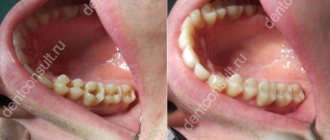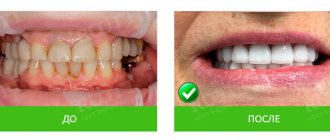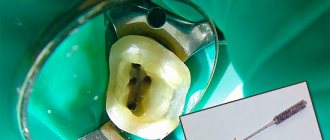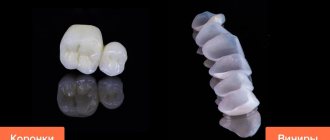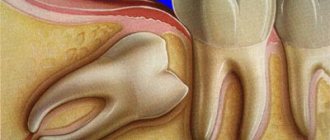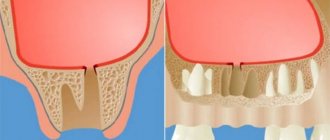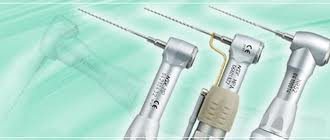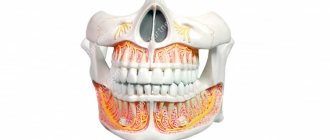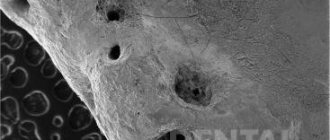641
In order to create a material with optimal technical and aesthetic characteristics that can be used for dental prosthetics, new research and development is constantly being carried out in the field of pharmaceuticals.
This is how a composite material enriched with ceramics was created - ceramic composite or ceramer.
Crowns made from this composition have low weight, aesthetic appearance, high strength and wear resistance, and therefore can be used for prosthetics of both molars and frontal incisors.
General overview
Ceramic composite is a highly filled composite composition containing ceramic particles as a filler.
Depending on the type of material, the mass fraction of ceramics can range from 70% to 86%. The particle size does not exceed 0.6 microns, due to which the product has a high degree of polishability.
The frame of the crown can be made of fiberglass, cobalt chrome alloy or zirconium oxide. The metal base is thin, so it is not visible through the dense layer of ceramic composite. This allows the use of prostheses to restore the frontal row units.
Application area
Ceramic composite crowns have a wide range of applications. They are installed both on teeth containing neurovascular bundles and on row units that lack pulp.
In addition, such crowns can be an integral part of a bridge structure or used as a prosthesis supported by implants.
Due to their low weight, ceramic composite prostheses can be fixed both in a classical way and in a method that involves creating an immediate load.
Installing a crown on a tooth stump involves the use of an adhesive adhesive composition, which not only fixes the product, but also increases its strength characteristics.
In the case of primary prosthetics with implants, fixation of a ceramic-composite crown requires the patient to have no natural tooth for at least six months or to wear a full removable structure for a long time.
Purpose of dental ceramics and expert opinions about the material.
Come here to learn more about possible complications after dental prosthetics.
At this address https://zubovv.ru/protezirovanie/nesemnyie-p/osnovyi-pri-parodontoze.html we will talk about methods of prosthetics for periodontal disease.
Scope of application of ceramic composite prostheses
At the Smile-at-Once clinic, porcelain composite is used to a greater extent to create implant-supported dentures. The material is lightweight, which is very important when using dental implantation methods with immediate loading (Basal Complex and All-on-6) - such dentures can be immediately loaded without the risk of displacement of the installed implants. In addition, the metal base ensures uniform distribution of the chewing load and connects the implants into a single structure, literally stabilizing them in a given position.
Ceramic-composite dentures are created in a laboratory based on previously prepared dental casts, as well as using 3D computer modeling. To make a prosthesis, a plastic base is used, which is lined with a plastic mass of keromer, that is, the crown consists of 5 layers. The material then hardens under the influence of a polymerization lamp. At the end of the process, the finished denture is carefully polished to give the artificial enamel a smooth finish.
What patients say about treatment
Sergey Vladimirovich Re-prosthetics after complex implantation all-on-6: new teeth once and for all!
Valentina Ivanovna Re-prosthetics one year after basal dental implantation
Natalya Vladimirovna 1.5 years after all-on-4 implantation: re-prosthetics
Samvel Zavenovich Re-prosthetics after complex implantation all-on-4
Surkova Lyubov Anatolyevna 1.5 years after all-on-6 implantation
Zhanna Anatolyevna Thank you for the great mood and beautiful smile!
— Re-prosthetics after complex implantation all-on-6: new teeth once and for all!
Our patient Sergey together with his doctor - orthopedic dentist Zhargal Dulgarov - after complex implantation of all-on-6 and subsequent re-prosthetics.
Sergey Vladimirovich
Re-prosthetics after complex implantation all-on-6: new teeth once and for all!
Doctor: Specialization: Experience:
3 days
View all reviews
— Re-prosthetics one year after basal dental implantation
Photo as a souvenir with the attending physician - orthopedic dentist Dmitry Creamer after re-prosthetics: changing the adaptive prosthesis to a permanent one a year after basal dental implantation.
Valentina Ivanovna
Re-prosthetics one year after basal dental implantation
Doctor: Specialization: Experience:
3 days
View all reviews
— 1.5 years after all-on-4 implantation: re-prosthetics
With orthopedic dentist Zhargal Dulgarov after changing the adaptive prosthesis to a permanent one. The patient began treatment in our clinic back in May 2020. During this time, all-on-4 implantation was performed on original Nobel Biocare implants with immediate and delayed loading. A permanent prosthesis was installed on one jaw in November, now it’s time to re-prosthetize the second jaw. The patient chose a comfortable option made of ceramic composite – a durable and very aesthetic material.
Natalya Vladimirovna
1.5 years after all-on-4 implantation: re-prosthetics
Doctor: Specialization: Experience:
3 days
View all reviews
— Re-prosthetics after complex implantation all-on-4
With words of gratitude for a new life! Re-prosthetics after complex implantation of all teeth using the all-on-4 protocol on original Nobel Biocare implants. At the first stage, an adaptive prosthesis was installed, at the second - from a durable ceramic composite.
Samvel Zavenovich
Re-prosthetics after complex implantation of all-on-4
Doctor: Specialization: Experience:
3 days
View all reviews
— 1.5 years after all-on-6 implantation
With orthopedic dentist Dmitry Creamer almost 1.5 years after complex implantation using the all-on-6 protocol on Nobel Biocare brand implants. Re-prosthetics were carried out using a complex of digital diagnostics and planning to produce the most comfortable prosthesis.
Surkova Lyubov Anatolevna
1.5 years after all-on-6 implantation
Doctor: Specialization: Experience:
3 days
View all reviews
— Thank you for the great mood and beautiful smile!
Re-prosthetics 1 year after basal dental implantation. The patient notes excellent diction and great mood! In the photo - with orthopedic dentist Stanislav Chorny: “I express my deep gratitude for the jewelry work done - comprehensive dental prosthetics! It is very pleasant when a doctor not only hears and understands his patients, but also skillfully brings to life subtle and aesthetic beauty, painstakingly paying attention to every detail. Teeth become a reality - they are a chic adornment for a woman! Thank you, Stanislav Vladimirovich, for your hard work, patience, and caring attitude towards patients. Always a good mood and warmth emanating from you! Doctor from God, you have golden hands! More grateful patients to you, decorate people and the world with your wonderful works!”
Zhanna Anatolyevna
Thank you for the great mood and beautiful smile!
Doctor: Specialization: Experience:
3 days
View all reviews
Advantages of ceramic composite
- high aesthetics: achieved by adding ceramic components to the composite,
- natural transparency, especially in combination with fiberglass, which is white and does not show through under the veneer of crowns,
- an ideal option for prosthetics on implants: fiberglass is a strong and durable material, with characteristics comparable to ordinary metal. At the same time, it has much less weight (like ceramic-composite crowns themselves) - prostheses made from a combination of two similar materials, under certain conditions, can be fixed to implants immediately after their installation, without the risk of displacement,
- Resistant to coloring even when exposed to food coloring,
- no allergic reactions,
- strength comparable to metal-ceramic crowns,
- simple and fast production,
- possibility of repair: correction of the structure is carried out directly in the patient’s mouth, without removing the prosthesis. The chipped piece is filled with ceramic composite material, which hardens under the influence of a special lamp.
Disadvantages of dentures
Compared to classic ceramics, which chip when overloaded, ceramic composite is characterized by adaptive abrasion. However, this is a relative disadvantage, since such crowns allow you to preserve the enamel of natural or artificial teeth of the opposite row. Other disadvantages include increased accumulation of plaque due to poor oral hygiene on the part of the patient.
Compared to metal-plastic ones, such prostheses have a higher cost, which is due to simple and quick repairability, as well as improved aesthetics.
Indications and contraindications
Due to the high degree of filling of the material, the products can be used in the following situations:
- restoration of destroyed units in the frontal or chewing area of the jaw arch;
- fabrication of a bridge structure to replace several missing row units located in the vicinity;
- fastening of single crowns or bridges on implants.
Among the contraindications for installation, dentists note the following points:
- the possibility of an allergic reaction to the constituent elements of the structure, in particular the metal frame;
- high abrasion of enamel as a result of bruxism;
- patient age under 15 years;
- the presence of inflammatory gum diseases.
Advantages and disadvantages
According to dentists, ceramic-composite crowns have many advantages, which makes them very popular in modern prosthetics.
The main ones are as follows:
- High levels of aesthetics. Due to the high mass fraction of ceramics, the products are identical in appearance to human enamel, which allows them to be used to restore teeth in the smile area.
- Versatility in prosthetics. With the help of dentures, it is possible to restore both the frontal units of the row and chewing teeth. Installing crowns on implants allows for immediate loading.
- High strength of crowns. The products have increased resistance to cracks and chips of the material and can withstand high loads.
- Wide range of material shades. Allows you to choose the color of the crown that best matches the rest of the patient’s teeth.
- Low weight of the prosthesis in comparison with structures made from other materials.
- Possibility of crown repair. When a fragment of an artificial tooth is chipped off, the dentist has the opportunity to adjust the shape directly in the patient’s mouth without removing it.
This is done by applying the composition to the prosthesis and exposing it to a special lamp, due to which the hardening process occurs. - Resistance of the material to staining. Ceramer dentures do not change color when exposed to food coloring.
- High level of biological compatibility with oral tissues.
The design is not without its drawbacks, some of which are quite significant:
- have a large thickness, which requires strong grinding of the teeth;
- the presence of a polymer material in the design entails an increased rate of formation of bacterial plaque, which imposes special requirements on the quality of oral hygiene;
- the material has slight shrinkage;
- There are contraindications for installation for certain categories of people.
The cost of ceramic composite prostheses is a rather relative indicator. It significantly exceeds the price of metal-plastic products, but is acceptable in comparison with crowns made of pure ceramics.
Let's figure out why the crown on the implant is loose and what is done in such a situation.
In this article we will look at the symptoms of an allergy to crowns.
Here https://zubovv.ru/protezirovanie/nesemnyie-p/vse-tonkostiv-gorode-heyhe.html we’ll talk about the benefits of dental prosthetics in Heihe.
Advantages of the material
Crowns made of ceramic composite have a lot of positive qualities and are devoid of a large number of disadvantages that the materials included in the composition have. Such crowns, for example, have very high strength in both compression and expansion of the jaw. Correctors look very aesthetically pleasing due to the presence of ceramics in the material.
In many situations, a crown of this format can be repaired without much effort. The finished material weighs very little compared to other options. When consuming any food or drink, the color of the keromer remains the same as originally, without being stained.
The material has extremely low allergenicity and does not cause adverse reactions. When using such crowns, abrasion resistance occurs due to the ceramic base, and the low abrasiveness protects the teeth that come into contact with the material. Keromer is universal and technologically advanced, which is why the material is used for the manufacture of implants.
Negative sides
| Click to sign up for a FREE consultation |
Despite such an abundance of positive qualities, keromer is also endowed with disadvantages, some of which are important and should not be overlooked. Among the shortcomings, it is worth noting the gradual shrinkage of the material during operation. Although the figure is small, you still need to take this into account when installing.
A larger amount of plaque forms in the oral cavity due to the presence of polymer in the material. Installation of such crowns and dentures will require constant oral care. When using ceramics of this type, the occurrence of abrasion of the surface by natural teeth is noted.
The cost of such crowns is very high compared to other types of material. An extensive list of contraindications is provided, which must be discussed in advance with your doctor. Another drawback is the grinding requirements of the tooth on which the crown is placed due to the thickness of the walls of the implant.
Manufacturing and installation technology
The creation of ceramic-composite crowns is carried out in a dental laboratory based on casts of the patient’s jaw rows. After the prosthesis is manufactured, it is transferred to a specialist who will carry out fixation.
The procedure for installing an artificial crown can be carried out in several ways:
- Fixation on your own tooth, in which the nerve is preserved. The operation is only possible if there is no metal frame, otherwise there is a risk of pulp inflammation. The crown is fixed with a special cement composition.
- Strengthening a damaged natural tooth. The procedure is carried out in case of destruction of a significant amount of tissue of a row unit and preservation of the root.
Prosthetics are performed as follows: a pin is fixed inside the root, strengthened with filling material, and then a crown is attached. - Prosthetics on implants. The method is used in cases of complete absence of both the crown and root parts.
The implant is inserted into a special hole in the gum and bone tissue, after which the abutment and prosthesis are fixed on it. Simultaneous implantation is possible due to the low weight of ceramic-composite crowns, which eliminates the risk of their displacement after applying a load.
Repairing an installed prosthesis also has its own peculiarities. When a section of the crown is chipped, restoration work is carried out in the patient’s oral cavity without removing the product.
The dentist applies the ceramic composite material layer by layer and dries it using a lamp.
Materials and production of ceramic-composite crowns
The crowns have a metal base - cobalt-chrome alloy. It can cause allergic reactions in some patients, so the option of using precious inert metals is possible (however, this significantly increases the cost of crowns). On top, the metal base is covered with several layers of photopolymer composites with a mixture of ceramics, the shade of which is selected in accordance with the color of the enamel of living teeth that are preserved in the oral cavity.
Light composites are materials that are actively used in dentistry for filling teeth, restoring chips and cracks, and creating composite veneers. They shrink slightly over time, but this does not affect the shape of the tooth at all - it retains its full functionality.
Composites may also be susceptible to discoloration if the patient frequently consumes coffee, black tea, red wine, and foods containing coloring pigments. However, this is a relative disadvantage of dentures, since the aesthetics are only slightly affected, and with careful and regular hygiene, the color of the crowns can be preserved until the end of their service life.
Advantages
- quite high aesthetics,
- easy installation,
- the possibility of repairing the crown directly in the oral cavity,
- versatility – suitable for restoring both anterior and posterior teeth,
- suitable for implant prosthetics,
- the surrounding teeth are not injured - the composite does not exert excessive pressure on them,
- low price.
Flaws
- allergic reactions are possible,
- the material shrinks slightly,
- requires quite a strong grinding of the tooth,
- not suitable for patients with bruxism and pathological abrasion of enamel.
Features of installing crowns
Ceramic composite crowns, as a rule, are not used to create removable dentures. They are suitable for single restorations as well as short-term dental bridges (up to 5 crowns in a row). Among the features of their use are the following:
- preservation of the dental nerve: dental crowns with a metal base require removal of the tooth root. The specialists of our center always try to keep the tooth alive for as long as possible, but the presence of metal located close to the nerve can cause inflammation of the pulp under the crown, which will require surgical removal of the prosthesis, and it will not be possible to re-attach it,
- strengthening a living tooth: if the coronal part is completely destroyed, but the tooth root is preserved, it can be strengthened and built up - a pin or stump inlay can be installed inside the root, and a crown can be fixed on top. This option will extend the life of the tooth by at least another 3-5 years, and often by several decades,
- prosthetics on implants: these crowns are ideal for prosthetics on implants, especially when immediate loading of structures is required. They are distinguished by their low weight, excellent aesthetics and fairly long service life, which allows them to be replaced at least 5-7 years after installation,
- possibility of repair: the metal base is made of metal covered with a layer of composite, which, if chipped, can be restored by applying a small amount of new photopolymer to the defect site.
Otherwise, ceramic composite crowns are created using traditional technology: individually for the patient in the laboratory based on impressions taken.
Life time
The service life of the products starts from 10 years, but this period can be significantly increased with proper care of the prostheses.
The material requires careful removal of plaque at least twice a day. For this purpose, dentists recommend using not only brushes, but also auxiliary devices - floss, irrigator, brush.
If a section of the crown is chipped, you should contact a dental center where repairs will be carried out. The procedure is carried out during the same visit and takes no more than one hour.
Comparison with metal-plastic
Patients are often interested in whether there are significant differences between prostheses made of ceramic composite and metal-plastic.
Dentists note that products made from these materials differ significantly in performance characteristics.
| Index | Ceramic composite prosthesis | Metal-plastic prosthesis |
| Aesthetics | Externally, it is practically indistinguishable from the patient’s own teeth due to a wide range of shades of the material, high polishability and light transmittance | The resemblance to your own teeth is quite high, however, the color reproduction is not very accurate |
| Preservation of appearance | Maintains the original color scheme throughout the entire period of operation | Under the influence of coloring products, the color changes after a year of use. |
| Possibility of repairs | It is possible to perform repair work directly in the oral cavity without the need to remove | |
| The need for re-prosthetics | There is no need to wear a removable denture if you have been missing teeth for six months or for long periods of time | Mandatory after a year or a year and a half or in case of breakdown |
| Dental center guarantee | 5 years | 1 year |
| Duration of operation | From 10 years or more with quality care | No more than 5 years |
Aesthetic restoration using composite material
Currently, dental materials largely determine the quality of services provided. When we talk about materials that are used every day, we are mainly talking about composites, which are an integral part of everyday practice. Most often, patients want fast, high-quality and inexpensive treatment. It is quite difficult to satisfy all of the above requirements, although the technologies already available and accessible to us allow us to get closer to this goal; however, when it comes to composite restorations, they should not be considered long-term, unlike fixed prosthetics.
This article describes how to carry out restorative treatment relatively quickly, inexpensively and at the same time satisfy the aesthetic needs of the patient, although the initial situation was quite complex and there seemed to be every reason for treatment with orthopedic structures.
The patient, 35 years old, came to the clinic for the manufacture of dental restorations (Fig. 1), which were financially acceptable to her and in a fairly short period of time. The patient smokes, but her oral hygiene was satisfactory. Before the start of restorative treatment, hard and soft dental plaque was removed (Fig. 2), and the base color of future restorations was determined using the GC G-aenial shade scale. Next, an impression was taken from the palatal surface of the teeth to make a silicone key. All carious lesions of the hard tissues of the teeth in the frontal region of the upper jaw (13–23) were removed after preliminary staining with a caries detector (Fig. 2).
Rice. 1. Initial situation.
Rice. 2. Teeth 13–23 after preparation: old restorations and infected hard tissues were removed.
After removal of all the old restorations and infected dentin, quite extensive hard tissue defects arose that required more extensive reconstruction in the oral-vestibular direction. Therefore, for the manufacture of restorations, the technique of layer-by-layer application of several shades of the composite was chosen, since the result using only the main shades of the composite would be aesthetically unacceptable and would not eliminate the dark translucency from the oral cavity. Modeling began with the reconstruction of the palatal part of the lost hard tissues (enamel shades were used composite); During the modeling process, a pre-fabricated silicone key was used (Fig. 3).
Rice. 3. Trying on a silicone key.
After isolating the deeper areas of the preparation (GC Bond LC) (Fig. 4), the remaining hard tissue from the palatal surface was conditioned (Fig. 5).
Rice. 4. Isolation of deeper preparation areas using GC Fuji Bond LC.
Rice. 5. Conditioning of the remaining hard tissues from the palatal surface.
To ensure the required thickness of the restoration in the oral-vestibular direction, the use of a prefabricated silicone key is very important (Fig. 6).
Rice. 6. Modeling the palatal wall of the restoration using a silicone key.
During its manufacturing process, the exact contours of the palatal surface of the working area are reproduced before the removal of failed restorations and diseased tissues, which subsequently makes it possible to reproduce the natural functional anatomy of the teeth, as well as significantly reduce the time required to complete the restoration.
For layer-by-layer modeling of the restoration, the author was pleased to use the new modern restorative composite GC G-aenial and was pleasantly surprised by the ease of its use (Fig. 7, 8).
Rice. 7. Selecting the main shade of the GC G-aenial material.
Rice. 8. Restorative composite GC G-aenial and shade scale.
First, it was necessary to choose the main shade, and then select special shades for it (opaque for deep layers of restoration and translucent for superficial layers). The goal of layer-by-layer modeling (from the cervical region to the incisal edge) is to achieve the most natural appearance of the restoration, which will blend with the surrounding natural teeth of both the upper and lower jaw.
Already after the first stage of treatment, the patient was quite satisfied with the shape and shade of the teeth (Fig. 9); however, to achieve the optimal final result, it was necessary to carry out another modeling step, during which the anatomy of the labial surface of the restorations was improved, and the restorations were given an even more natural appearance, depth and three-dimensionality of color through the application of small strokes of special shades of the composite.
Rice. 9. The first stage of treatment has been completed.
After installing the rubber dam, the teeth were repeatedly coated with matte monochromatic varnish (Fig. 10), which emphasized all the structural and textural features of the vestibular surfaces of the restorations; after finishing treatment with abrasive stones and discs (Arkansas stones, Shofu polishing discs), the surface acquired an even more natural appearance and natural shine, similar to the natural reflectivity of teeth (mirror reflection) (Fig. 11, photo taken using a lamp with a reflector). Because The polishing process takes considerable time, the patient was scheduled for another appointment, during which every detail of the surface was analyzed under 12.5x magnification, after which all defects of the restorations were identified and corrected. GC Diapolisher Paste was chosen for polishing; it can be used for polishing both composites and ceramics and when used correctly (soft rubber discs, low pressure on the polishing area, medium speed) guarantees excellent results.
Rice. 10. Matte varnish emphasizes all the textural features of the vestibular surfaces of the restorations.
Rice. 11. The surface of restorations of teeth 13–23 acquired a natural shine after finishing treatment.
Nanoparticles are distributed extremely evenly in the paste (fine ceramic filler, xylitol and mint flavor), which allows you to polish composites and ceramics with a high degree of efficiency.
In daylight, the results were even more impressive than in artificial light (Figure 12), and the patient was very pleased with the final appearance of her new smile (Figure 13).
Rice. 12. Appearance of teeth in daylight: impressive result.
Rice. 13. Before and after treatment.
The reflection of light from the deep layers of the composite is called diffuse reflection - it determines light transmittance, tone and color saturation; the level of shine (the so-called pearl effect) achieved by polishing the surface is called specular reflection. The color of the restoration depends on three parameters: the color itself (tone), color saturation (chroma) and color lightness (brightness), but light transmittance (the ability of the material to transmit light, but only diffused light) is no less important. Internal tooth structures (eg, enamel prisms, dentin-enamel interface areas, and dentinal tubules) scatter and reflect light. Some wavelengths of light are absorbed, while the rest of the light, which carries information about color hue, saturation, and brightness, is diffusely reflected. For example, enamel, consisting mainly of apatite crystals, transmits the light flux with virtually no scattering, while dentin, which has a more complex structure, including hydroxyapatite crystals and collagen fibers, scatters the light flux in all directions - diffusely.
In order for composite materials to blend perfectly with the adjacent tooth structures, they must have the same or as similar properties as possible. GC G-aenial contains pre-polymerized fillers, which provide exceptionally high aesthetics and also impart radiopacity to the material. These pre-polymerized fillers (strontium and lanthanide fluorides) also cause a low degree of polymerization shrinkage of the material. G-aenial Anterior (there is also a posterior version of the material for performing restorations of the chewing group of teeth) has the maximum dispersive ability among competing analogues, due to which, when used, an exceptionally high “chameleon effect” is achieved, and restorations of the most natural appearance can be performed using just one shade of material.
The modulus of elasticity and resistance to cracking (a measure of the stiffness of a material, also known as Young's modulus) of the composite material should not be too high so that the material itself has the ability to absorb the masticatory load on the restoration. Based on research and testing, GC G-aenial Anterior is one of the most flexible dental composite materials available, yet its ability to resist cracking is comparable to that of competing composites. GC G-aenial has also been proven to have one of the lowest polymerization shrinkage stress rates among competing materials. The abrasion of the material is similar to this indicator for nanohybrid composites.
conclusions
Based on the above data and the description of the clinical case, it can be concluded (which is also my personal recommendation) that the dispersive ability of the GC G-aenial material is so close to that of natural teeth that it allows you to create natural esthetics using direct composite restorations faster and easier than using materials that are more difficult to work with.
The list of references is in the editorial office.
Alternatives
At the first stage of prosthetics on implants, crowns made of metal composite material can be considered as an alternative option. They have similar properties, in particular, the possibility of repair without removal from the patient’s mouth.
During the second stage of prosthetics, there are more alternative options. Dentists can offer products made from metal ceramics or zirconium oxide.
Such crowns are characterized by high strength, wear resistance and aesthetics, but have a higher cost.
The video presents an expert's opinion on the material.
Stock
-19%
German implants XIVE Friadent 80,000 rub.
65,000 rub.
get -16 %
Premium implantation Nobel and zirconium dioxide crown 125,000 rub.
105,000 rub.
get -62 %
Metal-free dental crown made of zirconium dioxide 25,000 rub.
9500 rub.
get -20 %
Quadrotti dentures (without palate) 40,000 rub.
32,000 rub. get
Reviews
Ceramic composite is a high-tech material with high performance and aesthetic characteristics.
Crowns, inlays, and bridge structures made from it can be used both to restore the chewing elements of a row and to recreate the front teeth.
Share your experience using ceramic crowns in the comments section of the article.
If you find an error, please select a piece of text and press Ctrl+Enter.
Tags crowns prosthetics
Did you like the article? stay tuned
No comments yet
